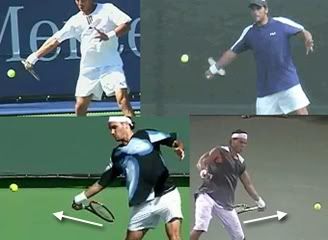
I just borrowed Jeff Count's photo here from his article on the straight armed forehand to ask a question.
I've been intrigued by this position since first learning of it from Jeff's site and talking to him about it. I THINK he believes this COULD be one of the reasons why Federer and Nadal's forehands are so unique, powerful and explosive. Would it in your opinion, be worth investigating this aspect of the stroke more. From the position above to contact and just after contact, to see what makes these two forehands unique? I know you've done two very detailed articles on the Federer forehand and one on Rafa's but I thought it might be interesting investigating this further.
I think Jeff puts Roger's forehand down to extreme torque combined with maximum leverage but he'd be able to help me out more there with the explanation.
Would just like to get your opinion on the above pictures and how it affects the strokes. Surely it allows you to store more kinetic energy which will later be released?



 )
)
Comment